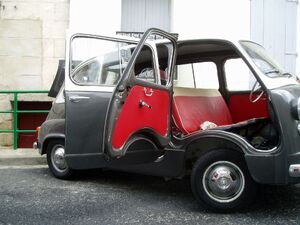
A suicide door on a Delahaye Type 135
A suicide door is a car door hinged on the pillar rear to its placement: a front suicide door would be hinged to the B-Pillar (center) and a rear door to the C-Pillar (rear).[1][2][3] Such doors were originally used on horse-drawn carriages,[4] but they are rarely used on modern vehicles, due primarily to safety concerns. Although the term is common in the custom car trade,[5][dead link] it is avoided by major automobile manufacturers in favor of terms such as "coach doors" (Rolls-Royce),[3] "FlexDoors" (Opel)[6] "freestyle doors" (Mazda),[3] "rear access doors" (Saturn),[3] and "rear-hinged doors".[1]
The original reasoning for the term 'Suicide Door' was due to the possibility of a door being hit by traffic at speed while someone exits the vehicle. A conventional door will break off, while a Suicide Door will slam closed, injuring the driver/passenger.
History[]

The Fiat 600 Multipla is an example of a car with both suicide and conventional doors.
Suicide doors were common on cars manufactured in the first half of the 20th century.[1] In the era before seat belts, the accidental opening of such doors meant that there was a greater risk of falling out of the vehicle compared to front-hinged doors, where airflow pushed the doors closed rather than opening them further. Suicide doors were especially popular in the gangster era of the 1930s, supposedly due to the ease of pushing passengers out of moving vehicles with the feature, according to Dave Brownell, the former editor of Hemmings Motor News.[3]
After World War II, the use of suicide doors was mostly limited to rear doors of four-door sedans. The best-known use of suicide doors on post-World War II automobiles was the Lincoln Continental sedans and convertibles in the 1960s.[3] Oliver Douglas, the protagonist of American television show Green Acres owned a Lincoln Continental convertible.[7] Also, on the first two seasons of the TV show Mannix in 1967–1969, a black Lincoln Continental with suicide doors was used by different characters across several episodes, and a yellow Ford Thunderbird convertible with suicide doors was used in at least one episode. US President John F. Kennedy was assassinated in a modified 1961 Continental convertible, known as the SS-100-X.
Since the four-door Lincoln convertible did not have a center B-pillar, the rear door glass was designed to electrically retract a few inches when the rear doors were opened in order for the weatherstripping to clear the front door glass; consequently, passengers in the back seat had to crawl through to the front seat to exit if the car's battery was dead. This problem was not universal, however. The Fiat 600 Multipla, introduced in 1956, and the SEAT 800, introduced in 1963, were both four-door cars featuring front suicide doors and rear conventional doors, with all four doors connected to the B-pillars.
Modern use[]

A Lincoln concept car from 2009 with suicide doors; note the total lack of a B-pillar
For a time, the last mass-produced car model with independently opening suicide doors was the Ford Thunderbird four-door sedan from 1967 to 1971. The 1971 model was the last American production automobile to feature rear suicide doors; safety concerns prevented the subsequent use of such doors.[8] More recently, rear suicide doors that cannot be opened until the regular front doors are opened have been appearing on a number of vehicles, including extended-cab pickup trucks, the Saturn SC, the Saturn Ion QuadCoupe, the Honda Element, the Toyota FJ Cruiser, and the Mazda RX-8.[1] In 2003, the new Rolls-Royce Phantom reintroduced independent suicide doors. Other models with classic suicide doors include the Spyker D8 and the Rolls-Royce Phantom Drophead Coupe four-seat convertible.
Rear passenger suicide doors had long been used on Austin FX4 hackney carriages. However, these models are being replaced by TX1s, which lack suicide doors.
Several concept cars have featured suicide doors, such as the Carbon Motors Corporation E7, a police car whose rear suicide doors are designed to help officers get handcuffed people in and out of the back seat. The Kia Naimo, an electric concept car, also has rear suicide doors.[9]
Other car manufacturers who have produced models with suicide doors include Austin, Citroën, Lancia, Opel, Panhard, Rover, Saab, Saturn, Škoda, and Volkswagen.
Advantages[]

An open rear suicide door on a Rolls-Royce Ghost
Rear-hinged doors make entering and exiting the vehicle much easier. They allow a passenger to enter in a natural way, by walking forward toward the vehicle and turning to sit, and to exit by stepping forward out of the vehicle. In combination with traditional front doors, they also make exiting easier for the driver, who can then reach the handle of the back door to open it for a passenger. In Austin FX4 taxis, drivers were able to reach the rear door handle through the driver's window without getting out of the vehicle.[citation (source) needed]
Disadvantages[]

Lloyd LT 600 van with a front suicide door
Conventional doors in the front and suicide doors in the back make exiting from the front and rear seats simultaneously difficult, due to the limited space between the front edge of the rear door and the rear edge of the front door.[citation (source) needed]
Suicide doors can create several unique hazards not applicable to conventional doors. If a passenger exits through a suicide door on a moving vehicle, the door will hit him or her.[10] Despite the use of safety latches or locks, aerodynamic factors can still lead to suicide doors being opened during driving. In 1969, Consumer Reports reported this problem on a Subaru 360.[11]
See also[]
- Butterfly doors
- Canopy doors
- Gull-wing doors
- List of cars with non-standard door designs
- Scissor doors
- Sliding doors
References[]
- ↑ 1.0 1.1 1.2 1.3 "Suicide Doors". Diseno-Art.com. Retrieved on 9 January 2013.
- ↑ "Dictionary of Historic Automotive Terms". Chalk Hill Media. Retrieved on 9 January 2013.
- ↑ 3.0 3.1 3.2 3.3 3.4 3.5 Mayersohn, Norman (11 July 2003). "Don't Call Them Suicide Doors". Retrieved on 9 January 2013.
- ↑ Anthony Bird & Francis Hutton-Stott, Lanchester Motorcars, A History, page 96, Cassell, London 1965
- ↑ Zimmerman, Martin (15 September 2007). "'Suicide doors' resurrected by car designers despite safety concerns". Retrieved on 11 June 2009.
- ↑ "New Meriva: unhinged". Top Gear (5 January 2010). Retrieved on 24 January 2011.
- ↑ "1967 Lincoln Continental Convertible (74A) in 'Green Acres, 1965–1971'". Internet Movie Cars Database. Retrieved on 15 September 2009.
- ↑ "Suicide Doors". Auto Brevity. Automotive Mileposts. Retrieved on 9 January 2013.
- ↑ Gorman, Michael (1 April 2011). "Kia Naimo concept EV debuts: 93mph, 124-mile range, and suicide doors". Retrieved on 6 January 2013.
- ↑ "FAQ – Exotic Door Tutorial". DeftRacing.com. Retrieved on 9 January 2013.
- ↑ "The Subaru 360 (Not Acceptable)". Consumer Reports 220–222 (April 1969). Retrieved on 24 January 2011.
| ||||||||||||||||||||||||||||||||||||||||||||||||||
| This page uses some content from Wikipedia. The original article was at Suicide door. The list of authors can be seen in the page history. As with Tractor & Construction Plant Wiki, the text of Wikipedia is available under the Creative Commons by Attribution License and/or GNU Free Documentation License. Please check page history for when the original article was copied to Wikia |